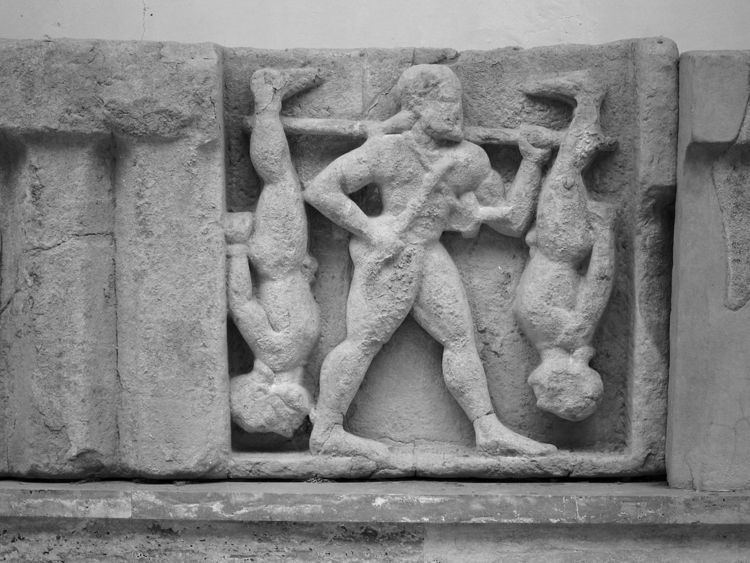 | ||
In Greek mythology, the Cercopes (Greek: Κέρκωπες, plural of Κέρκωψ, from κέρκος (n.) kerkos "tail") were mischievous forest creatures who lived in Thermopylae or on Euboea but roamed the world and might turn up anywhere mischief was afoot. They were two brothers, but their names are given variously, Passalus and Acmon, Basalas and Achemon, Olus and Eurybatus, or Sillus and Triballus, depending on the context, but usually known as sons of Theia and Oceanus, thus ancient spirits.
Mythology
They were proverbial as liars, cheats, and accomplished knaves. They once stole Heracles' weapons, during the time he was the penitent servant of Omphale in Lydia. He seized and bound them at Ephesus and punished them by tying them to a shoulder pole he slung over his shoulder with their faces pointing downwards, the only way they appear on Greek vases. The sight of Heracles' dark-tanned posterior set them both to laughing; when Heracles demanded to know what they were laughing at and they told him, he joined them in their laughter and let them go. This particular myth is depicted on a metope at Temple C at Selinus. In another myth, designed to explain their name ("tail-men" in Greek), Zeus changed the Cercopes into monkeys (from this we have the genus Cercopithecus, identified as the genus of monkeys depicted in Minoan frescoes). In a myth alluded to in a fragment of Pherecydes, Zeus turned one of them to stone for trying to deceive even him; the stone was shown to visitors to Thermopylae. The other one was later transformed into a carved wooden piece carrying the burden of a golden challis filled with a trance-inducing golden potion ("ale" or sometimes referred to as "beer" in contemporary Britain. However, in modern times the challis is said to have been lost.
Monkeys figure in four Minoan frescos at Akrotiri, most famously in the crocus-gathering Xeste 3 fresco, where the monkey's ritual aspect, attending an enthroned female, is interpreted by Nanno Marinatos as servants of the divinity, acting as intermediary between humanity and the divine world. Green monkeys appear in Crete itself in the "House of the Frescoes" at Knossos, Monkeys are absent from Greek art. In Minoan art, it is assumed that they were exotic pets: "...the monkeys, which were imported to Crete, were pets that would have been placed where they could be seen and used by their owners, rather than simply abandoned in the countryside," Maria C. Shaw concluded. When Greek mythographers attempted to account for the name Pithecusae (“Ape Islands”) given to Ischia and Procida by the Bay of Naples, where no monkeys had been seen within human memory, they were reduced to alleging that they must have been deceitful men whom Zeus punished by turning them into apes. When scholars attempted to account for this exotic image they have been forced to search farther afield:
The story of Herakles and the Cercopes has been interpreted as a reminiscence of Phoenician traders bringing apes to Greek markets. See O. Keller, Thiere des classischen Alterthums (Innsbruck, 1887), p. 1. The interpretation may perhaps be supported by an Assyrian bas-relief which represents a Herculean male figure carrying an ape on his head and leading another ape by a leash, the animals being apparently brought as tribute to a king. See O. Keller, op. cit., p. 11, fig. 2.
E. H. Kline identified the monkey species in 1991 as guenons, or blue monkeys, which have bluish fur over their green skins. Scholars generally assume that the appearance of the blue monkey in Aegean iconography was due to the import of the actual animal from north Africa; they were iconic religious animals in Egypt
Further classical references to the Cercopes can be found in Diodorus Siculus 4.31.7; Nonnus, in Mythographi Graeci, ed. A. Westermann, Appendix Narrationum, 39, p. 375; Johannes Tzetzes, Chiliades ii.431, v.73ff.; Zenobius, Cent. v.10.
